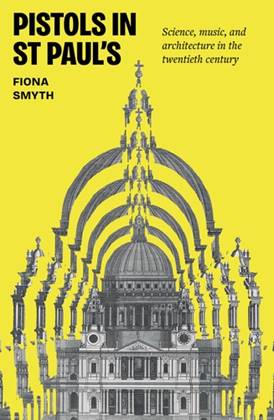In a previous article I discussed Sonic Tourism, traveling to delight the ears. I highlighted the Mormon Tabernacle in Salt Lake City as one building of note. I had been in Salt Lake City at that moment to visit the Acoustical Society of America’s Conference to present a project I had been working on as an undergraduate student. Combining the aural delight reverberating in an architectural beauty with the cutting edge research was something that I thought would be a rare experience for me. However, I received an advance copy of Pistols in St Paul’s: Science, music, and architecture in the twentieth century by Fiona Smyth to review and I was immersed in that convergence once again. This review is my honest reflection on Pistols in St Paul’s.
Fiona Smyth, an Associate Professor School of Art History and Cultural Policy at University College Dublin, is a historian of building science and acoustics. Pistols in St Paul’s is a culmination of years of research including her doctoral thesis. It is obvious from the first page that Smyth loves her subject, as care is taken to take the reader beyond the velvet rope of tour guides and into the drama of the history of Architectural Acoustics.
Architectural Acoustics is the science behind buildings as an instrument. The main methods of controlling the sonic ambience of a building is to either design it with acoustics in mind, and to add treatment once the building is completed. Quoting a theme from Pistols in St Paul’s, Architectural Acoustics is “the space between.” It is art and science, tangible and intangible. As a field it began as a multi-disciplinary collection of experts, and based on my own experience at an ASA convention it still is. A few of the fields that are represented in this book are physiology, SONAR, architecture, mechanical engineering, electronics, and physics.
Smyth begins her history of Architectural Acoustics starting in the late 1800’s and progressing to the titular event in the 1950’s. The sections are arranged chronologically, and grouped by major research experiments. Pistols of St Paul’s focuses on London and the influence of Royal Institute of British Architects (RIBA.) While there are excursions to the United States and British occupied India, it makes sense to focus on RIBA and their influence on the development of standards of practice. The narrative coming from one perspective allows the reader to focus on how an architect in England might have incorporated Acoustics into their designs over the years. There are physicists and architects who come together to quantize the field with observations and strategic concerts. There is also the realization of the importance of Acoustics that coincides with leaps in understanding sound as a science. But with every major leap forward there are setbacks that come from inflated egos, slow communication, and even world wars.
Another aspect that Smyth choses to focus on is the social importance of acoustics. Many of the buildings chosen for the experiments are public buildings used as gathering spaces. For these buildings they might be used for orchestral performances, speeches, debates, or a combination of the above. Buildings with infamous acoustics become maligned in the press. Other more fortunate buildings may be the key to boosting Post-War morale by hosting nation-building concerts.
Fiona Smyth draws you into the world with her anecdotes and descriptions, and the historical photos add to the context. While I did notice that RIBA and many of the characters in Pistols in St Paul’s are part of a boy’s club, there was an instance of women supporting women. Smyth calls out Emily Thompson’s contribution to the study of Acoustical History. And just like some of the characters in Pistols in St Paul’s there is across the pond multidisciplinary collaboration, with Thompson focusing more on the history of American Audio Technology. Overall, Pistol’s in St Paul’s is a riveting history of the formation of Acoustics as a serious field of science. I find it essential to the context of contemporary concert hall design. And to a casual tourist to Architectural Acoustics, it is an insightful museum guide.
